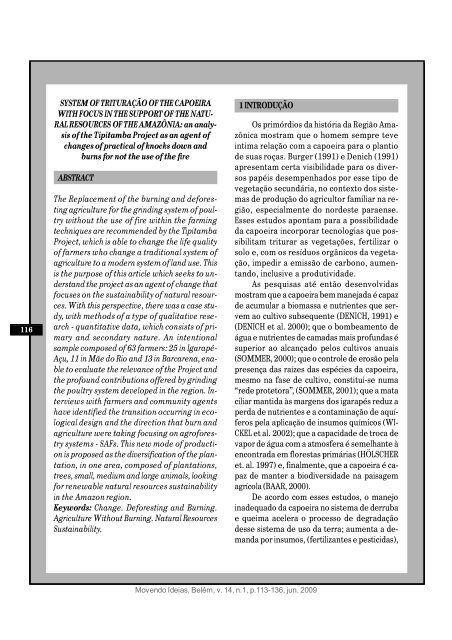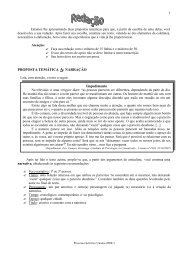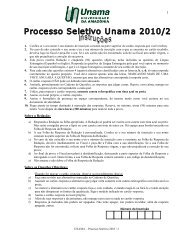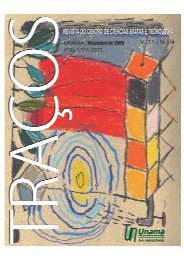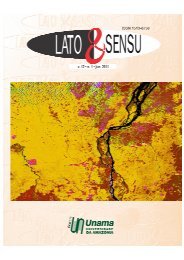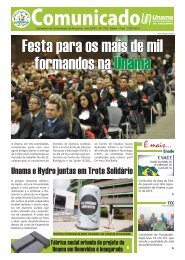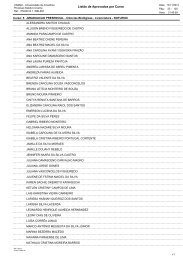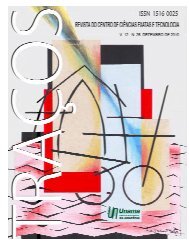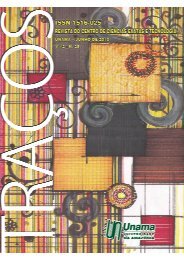C:\ARQUIVO DE TRABALHO 2010\EDI - Unama
C:\ARQUIVO DE TRABALHO 2010\EDI - Unama
C:\ARQUIVO DE TRABALHO 2010\EDI - Unama
Create successful ePaper yourself
Turn your PDF publications into a flip-book with our unique Google optimized e-Paper software.
116<br />
SYSTEM OF TRITURAÇÃO OF THE CAPOEIRA<br />
WITH FOCUS IN THE SUPPORT OF THE NATU-<br />
RAL RESOURCES OF THE AMAZÔNIA: an analysis<br />
of the Tipitamba Project as an agent of<br />
changes of practical of knocks down and<br />
burns for not the use of the fire<br />
ABSTRACT<br />
The Replacement of the burning and deforesting<br />
agriculture for the grinding system of poultry<br />
without the use of fire within the farming<br />
techniques are recommended by the Tipitamba<br />
Project, which is able to change the life quality<br />
of farmers who change a traditional system of<br />
agriculture to a modern system of land use. This<br />
is the purpose of this article which seeks to understand<br />
the project as an agent of change that<br />
focuses on the sustainability of natural resources.<br />
With this perspective, there was a case study,<br />
with methods of a type of qualitative research<br />
- quantitative data, which consists of primary<br />
and secondary nature. An intentional<br />
sample composed of 63 farmers: 25 in Igarapé-<br />
Açu, 11 in Mãe do Rio and 13 in Barcarena, enable<br />
to evaluate the relevance of the Project and<br />
the profound contributions offered by grinding<br />
the poultry system developed in the region. Interviews<br />
with farmers and community agents<br />
have identified the transition occurring in ecological<br />
design and the direction that burn and<br />
agriculture were taking focusing on agroforestry<br />
systems - SAFs. This new mode of production<br />
is proposed as the diversification of the plantation,<br />
in one area, composed of plantations,<br />
trees, small, medium and large animals, looking<br />
for renewable natural resources sustainability<br />
in the Amazon region.<br />
Keywords: Change. Deforesting and Burning.<br />
Agriculture Without Burning. Natural Resources<br />
Sustainability.<br />
1 INTRODUÇÃO<br />
Os primórdios da história da Região Amazônica<br />
mostram que o homem sempre teve<br />
intima relação com a capoeira para o plantio<br />
de suas roças. Burger (1991) e Denich (1991)<br />
apresentam certa visibilidade para os diversos<br />
papéis desempenhados por esse tipo de<br />
vegetação secundária, no contexto dos sistemas<br />
de produção do agricultor familiar na região,<br />
especialmente do nordeste paraense.<br />
Esses estudos apontam para a possibilidade<br />
da capoeira incorporar tecnologias que possibilitam<br />
triturar as vegetações, fertilizar o<br />
solo e, com os resíduos orgânicos da vegetação,<br />
impedir a emissão de carbono, aumentando,<br />
inclusive a produtividade.<br />
As pesquisas até então desenvolvidas<br />
mostram que a capoeira bem manejada é capaz<br />
de acumular a biomassa e nutrientes que servem<br />
ao cultivo subsequente (<strong>DE</strong>NICH, 1991) e<br />
(<strong>DE</strong>NICH et al. 2000); que o bombeamento de<br />
água e nutrientes de camadas mais profundas é<br />
superior ao alcançado pelos cultivos anuais<br />
(SOMMER, 2000); que o controle de erosão pela<br />
presença das raízes das espécies da capoeira,<br />
mesmo na fase de cultivo, constitui-se numa<br />
“rede protetora”, (SOMMER, 2001); que a mata<br />
ciliar mantida às margens dos igarapés reduz a<br />
perda de nutrientes e a contaminação de aquíferos<br />
pela aplicação de insumos químicos (WI-<br />
CKEL et al. 2002); que a capacidade de troca de<br />
vapor de água com a atmosfera é semelhante à<br />
encontrada em florestas primárias (HÖLSCHER<br />
et. al. 1997) e, finalmente, que a capoeira é capaz<br />
de manter a biodiversidade na paisagem<br />
agrícola (BAAR, 2000).<br />
De acordo com esses estudos, o manejo<br />
inadequado da capoeira no sistema de derruba<br />
e queima acelera o processo de degradação<br />
desse sistema de uso da terra; aumenta a demanda<br />
por insumos, (fertilizantes e pesticidas),<br />
Movendo Ideias, Belém, v. 14, n.1, p.113-136, jun. 2009


